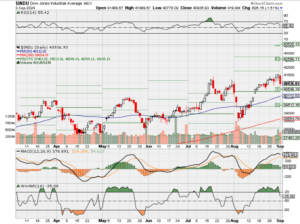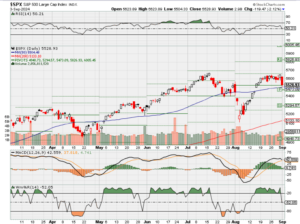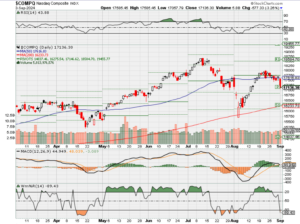HI Market View Commentary 09-03-2024
What About the old saying “Stocks Fall much Faster than they go up”
This causes anxiety and stress unless……..WE ARE PROTECTED
Do we make penny for penny on the way down?=NO because options have delta’s and it in your best interest to start ATM because you don’t want to overpay in case you are wrong on the direction
Kevin, What if you have expensive puts like NVDA and you pay $9 ATM and I only moves down $9 when the puts expire? What do you do? Sell a call or put to offset the cost, Convert the put value into shares
The whole HI or Warren Buffett trading/investing is to buy more shares in downward moving markets so that you get explosive results when the shares come back !!!
Right now AAPL, META, BAC, F are the two most common came back stocks
The ones we are waiting on = BIDU, DIS, MU, NVDA, SQ, UAA, TGT
NVDA
Long Put Protection
Short Call Protection
Because we have protection in place for some stocks we want the bottom to fall out on those position so we can add many more shares
I’ve heard a lot of money managers say “The market isn’t acting like it should”
Worst month and third worst month in the year for the markets are September/October
https://www.briefing.com/the-big-picture
The Big Picture
Last Updated: 30-Aug-24 14:40 ET | Archive
An investment strategy that pays dividends
Interest rates have come down in anticipation of policy rates coming down. That anticipation has been rooted in pleasing inflation news, some less than pleasing employment news, and the pleasant acknowledgment by Fed Chair Powell that, “The time has come for policy to adjust.”
Just how much and how fast that policy adjusts remains to be seen. The fed funds futures market thinks there will be 100 basis points of rate cuts before the end of the year followed by another 125 basis points before the end of 2025, according to the CME FedWatch Tool, leaving the target range for the fed funds rate at 3.00-3.25%.
The fed funds futures market is ambitious. The Fed’s Summary of Economic Projections provided in June showed a median estimate of 4.10% for the fed funds rate in 2025. New projections will be provided at the September FOMC meeting.
The fed funds futures market could end up being right, but it has been wrong on the pace and timing of rate cuts many times before.
In any case, the interest rate environment that has been friendly for savers since the Fed’s tightening campaign began in March 2022 is about to get a little less friendly. Interest rates offered on certificates of deposit will be coming down (and already have), interest rates on Treasuries will be coming down (and already have), interest rates on money market funds will be coming down, and interest rates on savings accounts will be coming down (or, in some cases, not going up from their still rock-bottom levels).
What that means, however, is that the fortunes of dividend-paying stocks should be turning up.
A Competition Factor
Let’s be clear. Dividend-paying stocks will still have their competition from investments offering less risk.
For example, the Annual Percentage Yield on a 1-yr online CD from Capital One is 4.50%; the yield on a 2-yr Treasury note is 3.92%; the 7-day SEC yield on the Vanguard Money Market Reserves Inc Federal Money Market Fund (VMFXX) is 5.26%; and a Lending Club savings account has an Annual Percentage Yield of 5.30%.
When the Fed cuts the policy rate, interest rate products will follow suit, maybe not step for basis point step but moving in the same direction of travel — a direction that Fed Chair Powell also said was clear (i.e., lower).
There isn’t going to be a mad dash to dividend-paying stocks, but we do anticipate there being a turn. It will be slow at first but it should pick up speed if, and when, a series of rate cuts comes to fruition.
The usual suspects will be in play (and already are). Think utilities, REITs, and energy, which generally have some of the most attractive dividend yields, as well as dividend growth. The same goes for the consumer staples sector.
Selection Matters
One needs to be more selective these days, however, when looking at dividend payers. The energy, REIT, and utilities sectors all have dividend yields in excess of 3.0%. None, however, have dividend yields higher than the risk-free 2-yr Treasury note.
That isn’t true of every sector component. Chevron (CVX), for instance, sports a 4.47% dividend yield. The point here is that stock selection is key for investors seeking income. There is an opportunity to extract more income from some individual components than there is from the sector as a whole. That is relevant if income generation is the main priority.
An S&P 500 index fund isn’t a great option for income generation. The dividend yield on the SPDR S&P 500 ETF (SPY), for instance, has a dividend yield of just 1.25%. That low yield is owed in large part to the fact that the S&P 500 is also trading near a record high.
To be sure, there are plenty of good dividend payers and higher dividend-yielding companies within the S&P 500, which, again, is why stock selection matters greatly for the income-oriented investor.
It matters because the economy is expected to slow. How much it slows is the great unknown, but labor market conditions will hold the answer. What we know now is that the labor market has softened, but it hasn’t broken. Initial jobless claims — a leading indicator — continue to run well below levels typically seen in recessions.
The unemployment rate of 4.3%, though, is up nearly a full percentage point from its low in April 2023 and up 0.4 percentage point in just the last three months. That move has caught the Fed’s attention and is a key reason why it is thought the time has come for policy to adjust. The aim is to forestall a worsening of the labor market with pro-active rate cuts; however, some think the Fed is already behind the curve in doing so.
What It All Means
A slowing of the economy, led by a slowdown in consumer spending, should lead to a slowdown in earnings growth. An outright recession, though, would most likely lead to a contraction in earnings growth. In either case, a prudent approach to dividend investing is to favor companies with a track record of not only paying dividends but increasing their dividend.
The best starting point in our estimation is the S&P 500 Dividend Aristocrats. To qualify, a company must be an S&P 500 component and increased its dividend every year for at least the past 25 years.
The “Aristocrat” distinction currently belongs to 66 companies, including luminaries like Coca-Cola (KO), Clorox (CLX), Walmart (WMT), Chevron (CVX), T. Rowe Price (TROW), and Johnson & Johnson (JNJ). One could favor individual stock selection among the Aristocrats or take a basket approach via an ETF like the S&P 500 Dividend Aristocrats ETF (NOBL). The latter fund’s explanation contains a list of all 66 Aristocrats.
Whether you favor a Dividend Aristocrat approach is up to you. There is always a place for dividend-paying stocks in a balanced portfolio looking to lower volatility and enhance total return potential.
That potential will be held dear in a tougher economic climate, were one to arise, and in an environment of falling interest rates that lessens the return potential of cash and cash proxies.
—Patrick J. O’Hare, Briefing.com
Earnings dates:
MU 09/25 est
Where will our markets end this week?
Lower
DJIA – Bullish
SPX – Bullish
COMP – Bearish
Where Will the SPX end September 2024?
09-03-2024 -2.00%
08-26-2024 -2.00%
Earnings:
Mon:
Tues:
Wed: DLTR, DKS, HPE
Thur: AVGO, DOCU
Fri: GCO
Econ Reports:
Mon: Durable Goods, Durable Ex-trans
Tue FHFA Housing Market Index, S&P Case Shiller, Consumer Confidence
Wed: MBA,
Thur: Initial Claims, Continuing Claims, GDP, GDP Deflator, Pending Home Sales,
Fri: Average Workweek, Non-Farm Payroll, Private Payroll, Unemployment Rate, Hourly Earnings
How am I looking to trade?
We Started taking protection off based on Technical Analysis
www.myhurleyinvestment.com = Blogsite
info@hurleyinvestments.com = Email
Questions???
The Bond Market is About to Do Something Noteworthy While NVIDIA is Distracting Everyone
August 30, 2024
While much of the market’s attention was directed towards Nvidia’s earnings report on Thursday, a significant development was unfolding in the bond market. The spread between the 2-year and 10-year Treasury yields, a well-known indicator of potential recession, is showing signs of returning to normal levels after being inverted for a considerable period.
On Thursday, the difference between the 10-year and 2-year Treasury yields had narrowed to less than 2 basis points, signaling a possible end to the inversion. This inversion, where short-term yields exceed long-term yields, is traditionally viewed as a warning of an impending economic downturn. However, the fact that the yield curve is normalizing does not necessarily indicate that the threat of a recession has passed.
Historically, the yield curve tends to normalize just before the onset of a recession. This is often because traders begin to anticipate that the Federal Reserve will need to lower interest rates to combat an economic slowdown. Currently, market expectations are aligned with the idea that the Fed may start cutting rates as early as September, with continued reductions likely through at least the end of 2025.
While the market commonly tracks the relationship between the 2-year and 10-year Treasury yields, the Federal Reserve pays closer attention to the spread between the 10-year and 3-month Treasury yields. As of July, this relationship indicated a 56% probability of a recession within the next 12 months, according to data from the New York Fed. However, this probability has been decreasing recently.
Nicholas Colas, co-founder of DataTrek Research, explained the dynamics behind this relationship in a recent market commentary. He noted that excessively high Fed Funds rates, which are closely tied to 3-month Treasury yields, often lead to recessions. The 10-year yield, on the other hand, reflects the market’s best estimate of the neutral rate of interest. When the Fed maintains policy rates above these levels, the U.S. economy tends to contract.
According to Colas, if this theory holds true, the U.S. economy may be facing a significant risk of an imminent recession. However, he also highlighted that recessions typically require an extraordinary event, such as a sharp increase in oil prices or a financial crisis, to trigger a downturn. In the absence of such a crisis, a recession has not yet materialized.
Despite this, Colas emphasized that the Federal Reserve is not off the hook when it comes to cutting interest rates over the next year. Market participants are well aware of this, which is why futures markets are pricing in rate cuts at every Fed meeting over the coming year. While this may seem aggressive, it aligns with the idea that the Fed needs to gradually return to a more neutral monetary policy stance in the foreseeable future.
As traders continue to monitor developments in both the bond market and the Federal Reserve’s policy decisions, the overall outlook remains uncertain. While the potential end of the yield curve inversion could be seen as a positive sign, it also raises concerns about the possibility of an impending recession. The Fed’s actions in the coming months will be crucial in determining the direction of the U.S. economy, as well as the bond market’s response to those actions.
In summary, while the bond market’s recent movements may offer some relief to traders concerned about a prolonged yield curve inversion, the broader implications for the economy remain unclear. The relationship between short-term and long-term Treasury yields has long been a reliable indicator of economic health, but it is not foolproof. As the Fed navigates its monetary policy decisions, the market will be closely watching for any signs that a recession could still be on the horizon.
35-year-old CEO shares the No. 1 red flag he sees in employees: People who aren’t self-aware ‘really struggle with this’
Published Wed, Aug 28 20242:27 PM EDTUpdated Wed, Aug 28 20244:13 PM EDT
Everette Taylor’s least-favorite trait in an employee is simple: a lack of self-awareness.
People without self-awareness tend to be “ego-driven” and less willing — or able — to work with other people, says Taylor, the CEO of crowdfunding platform Kickstarter. They’re prone to “thinking inwardly about what they would want and what they think is best when it comes to customers,” he tells CNBC Make It.
Self-aware employees are usually more open to ideas and pushback from their colleagues, Taylor says. The trait can help you bolster your communication, relationships, creativity and productivity, research shows.
But while 95% of people believe they’re self-aware, only 10% to 15% genuinely are, organizational psychology researcher and author Tasha Eurich found in 2018.
Taylor, 35, works on building his own self-awareness whenever possible, he says.
“I try to keep my ego at the door. I’m wrong all the time. I have an incredible team that’s super smart and will put me in my place, and I love that,” says Taylor.
Rooting out self-awareness in job interviews
Taylor, who’s been Kickstarter’s CEO since 2022, intentionally tailors job interview questions to focus on traits like self-awareness and ego control, he says. He asks about moments when the candidate got something wrong, or did something that failed.
His theory: No one has a perfect career, so someone who has difficulty discussing their faults may not know how to take accountability for their mistakes.
“You can really tell,” says Taylor. “The people that aren’t self-aware, they really struggle with this.”
Hiring managers commonly ask other questions to root out self-awareness, too. Ex-Google VP Claire Hughes Johnson asks candidates “how their colleagues would describe them. If they only say good things, I probe what constructive feedback they’ve received,” she wrote for Make It last year.
“Then I’ll say, ‘And what have you done to improve?’ to check their orientation towards learning and self-improvement, and to see whether they’ve taken that feedback to heart,” she continued.
Hughes Johnson listens closely for two words throughout any interviewee’s answers: Too many “I”s signify a lack of humility, and too many “we”s mean an inability to take credit appropriately.
To build your self-awareness, especially at work, consider asking your manager and colleagues directly about your strengths, neuroscientist and Columbia Business School instructor Juliette Han recommends. Which of your skills help the people around you the most? Which ones should you use more often?
“You can have all the technical skills and charisma in the world, but if you’re completely oblivious of yourself, how you come across and interact in the world, it’s a lot harder to build strong relationships, interact with your boss and co-workers and deepen the friendships you need to truly succeed,” Han told Make It last year.
Are you stressed about money? Sign up for CNBC’s new online course. We’ll teach you how to be more successful and confident with your money, and practical strategies to boost savings, get out of debt and invest for the future. Start today and use code EARLYBIRD for an introductory discount of 30% off through September 2, 2024.
Plus, sign up for CNBC Make It’s newsletter to get tips and tricks for success at work, with money and in life.
https://www.cnbc.com/2024/09/03/chart-analysts-see-encouraging-signs-for-stock-market-nvidia.html
Chart analysts see encouraging signs for stock market, Nvidia despite September’s poor history
Published Tue, Sep 3 202412:00 PM EDT
Jesse Pound@/in/jesse-pound@jesserpound
Wall Street is heading into a weak seasonal period after some August turbulence, but chart experts see reasons for optimism.
Several technical analysts from Wall Street shops published bullish notes over the Labor Day weekend. Strong market breadth was one highlight, embodied by the recent rally for the equal-weighted version of the S&P 500.
“Last week’s notable action included a new cycle high for the equal-weighted S&P 500, indicating the cap-weighted index has masked stronger internal action. The percentage of NYSE stocks above their 200-day average is similarly coming off a reading of 65%. We’re bullish on this count because we’ve found major market peaks are often undermined by a reading below 60%,” Ari Wald, technical analyst at Oppenheimer, said in a note to clients.
The equal-weighted version of the S&P 500 finished August on an uptrend.
September is typically a weak month for stocks. Over the last 50 years, this is the month with the worst average performance for the Dow Jones Industrial Average, according to Bespoke Investment Group. That history, combined with lingering concern about the steep sell-off on Aug. 5, has many traders prepared for some downside movement in the weeks ahead.
However, the S&P 500 did finish August up more than 2% for its fourth straight positive month, closing above 5,600.
“While we would still prefer a dip into 5400-5450 before a sustained breakout, the lack of any downside has us questioning that view. Path of least resistance is higher in early September, before downside volatility likely returns in the back-half of the month,” BTIG technical strategist Jonathan Krinsky said in a note to clients.
The set-up for the market’s most important stock also has some silver linings. Stephen Suttmeier of Bank of America said in a note to clients that Nvidia appears to have some close support that could make its next significant move another rally.
“NVDA is a semiconductor stock that consolidates within a bullish trend. Key supports are near 118 (chart level) and 110-106 (projected level and rising 26-week MA). If these supports hold, confidence in a bullish continuation pattern increases,” the note said.
The Nvidia chart could get put to the test quickly. Shares of the chipmaker fell more than 7% on Tuesday morning, trading just under $111.
— CNBC’s Michael Bloom contributed reporting.
CNBC Pro Talks: Mike Khouw on getting the most out of options and how to trade market turbulence
CNBC Pro Talks features one-on-one interviews with Wall Street’s top investors, smartest traders and rising stars. CNBC’s Dominic Chu finds out what makes them tick, what makes them money, and how you can follow in their footsteps.
There’s an opportunity to buy call options on Super Micro Computer after the recent sell-off in the stock, OpenInterest.PRO chief strategist Michael Khouw said.
That’s just one of the things the Wall Street veteran breaks down in his special Pro Talk with CNBC’s Michael Santoli.
Khouw first discusses:
- How his career as an options trader began
- The basics of options trading
- What he looks for when assessing a potential trade in this market
Then, for CNBC Pro subscribers only, he talks about:
- How he’s using options to navigate the recent market volatility
- Using options to trade Nvidia
- A potential market rotation out of the high-flying tech stocks into beaten-down sectors




